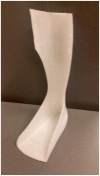Emerging Technology and Applications of 3D Printing in the Medical Field
- PMID: 30228770
- PMCID: PMC6140256
Emerging Technology and Applications of 3D Printing in the Medical Field
Abstract
3D printing technology evolved in the 1980s, but has made great strides in the last decade from both a cost and accessibility standpoint. While most printers are employed for commercial uses, medical 3D printing is a growing application which serves to aid physicians in the diagnosis, therapeutic planning, and potentially the treatment of patients with complex diseases. In this article we will delineate the types of printers available to the consumer, the various materials which can be utilized, and potential applications of 3D models in the healthcare field.
Figures







Similar articles
-
Applications of three-dimensional printing technology in urological practice.BJU Int. 2015 Nov;116(5):697-702. doi: 10.1111/bju.13183. Epub 2015 Jun 23. BJU Int. 2015. PMID: 26010346 Review.
-
Three-dimensional printing: technologies, applications, and limitations in neurosurgery.Biotechnol Adv. 2017 Sep;35(5):521-529. doi: 10.1016/j.biotechadv.2017.05.007. Epub 2017 May 24. Biotechnol Adv. 2017. PMID: 28552791 Review.
-
3D printing from MRI Data: Harnessing strengths and minimizing weaknesses.J Magn Reson Imaging. 2017 Mar;45(3):635-645. doi: 10.1002/jmri.25526. Epub 2016 Nov 22. J Magn Reson Imaging. 2017. PMID: 27875009 Review.
-
3D-printing and the effect on medical costs: a new era?Expert Rev Pharmacoecon Outcomes Res. 2016;16(1):23-32. doi: 10.1586/14737167.2016.1138860. Epub 2016 Jan 28. Expert Rev Pharmacoecon Outcomes Res. 2016. PMID: 26817398 Review.
-
How useful is 3D printing in maxillofacial surgery?J Stomatol Oral Maxillofac Surg. 2017 Sep;118(4):206-212. doi: 10.1016/j.jormas.2017.07.002. Epub 2017 Jul 18. J Stomatol Oral Maxillofac Surg. 2017. PMID: 28732777 Review.
Cited by
-
3D printed PLA Army-Navy retractors when used as linear retractors yield clinically acceptable tolerances.3D Print Med. 2019 Nov 21;5(1):16. doi: 10.1186/s41205-019-0053-z. 3D Print Med. 2019. PMID: 31754879 Free PMC article.
-
Development of Nanocoated Filaments for 3D Fused Deposition Modeling of Antibacterial and Antioxidant Materials.Polymers (Basel). 2022 Jun 29;14(13):2645. doi: 10.3390/polym14132645. Polymers (Basel). 2022. PMID: 35808690 Free PMC article.
-
The use of three-dimensional model construction of virtual technology in orthopedic treatment.Saudi J Biol Sci. 2020 Apr;27(4):1169-1173. doi: 10.1016/j.sjbs.2020.03.001. Epub 2020 Mar 10. Saudi J Biol Sci. 2020. PMID: 32256180 Free PMC article.
-
A Pilot Clinical Study of Ocular Prosthesis Fabricated by Three-dimensional Printing and Sublimation Technique.Korean J Ophthalmol. 2021 Feb;35(1):37-43. doi: 10.3341/kjo.2020.0125. Epub 2020 Dec 11. Korean J Ophthalmol. 2021. PMID: 33307623 Free PMC article.
-
Methods of 3D printing models of pituitary tumors.3D Print Med. 2021 Aug 31;7(1):24. doi: 10.1186/s41205-021-00118-4. 3D Print Med. 2021. PMID: 34462823 Free PMC article.
References
-
- Wenz SM, Zeichner SJ, Berg BI, Zeilhofer HF, Thieringer F. 3D Printed Surgical Simulation Models as educational tool by maxillofacial surgeons. s.l.: European Journal of Dental Education; 2018. [Epub ahead of print] - PubMed
-
- Yang T, Lin S, Tan T, Yanh J, Pan J, Hu C, Li J, Zou Y. Impact of 3D printing technology on comprehension of surgical anatomy of retroperitoneal tumor. s.l.: World Journal of Surgery; 2018. [Epub ahead of print] - PubMed
Publication types
MeSH terms
LinkOut - more resources
Full Text Sources
Medical
